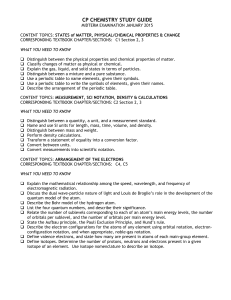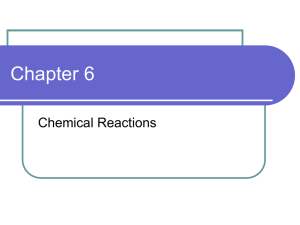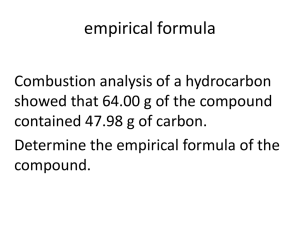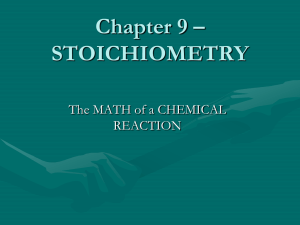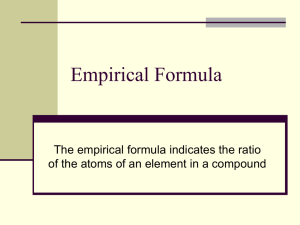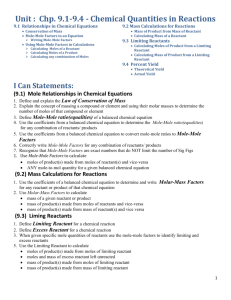2) Determine Formula
advertisement
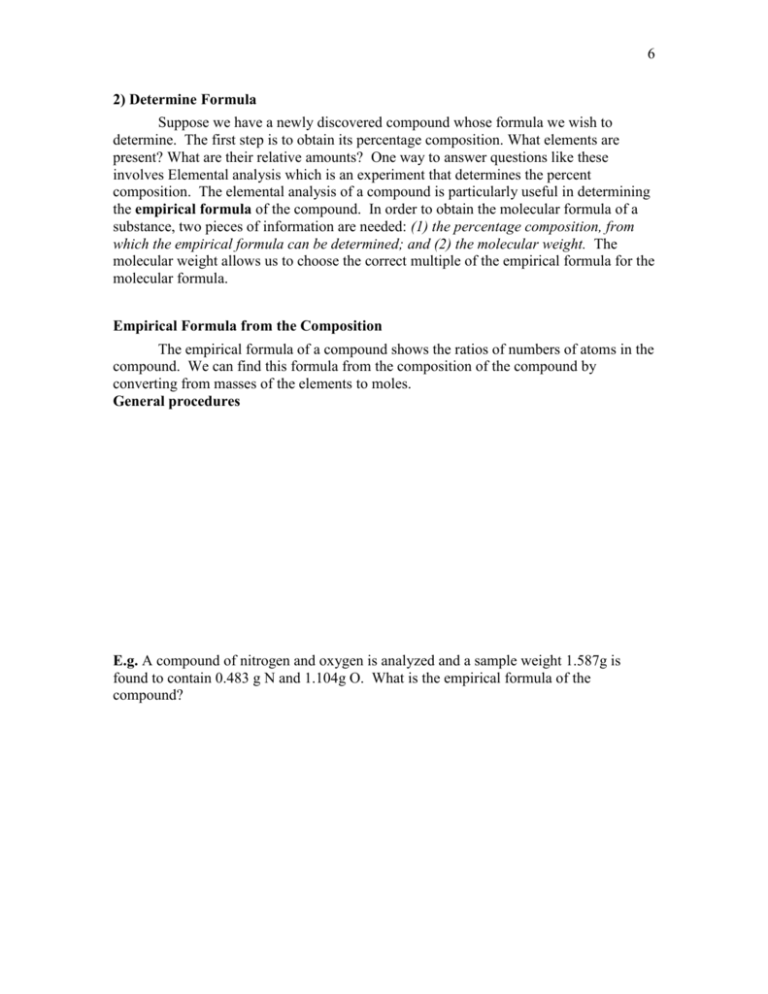
6 2) Determine Formula Suppose we have a newly discovered compound whose formula we wish to determine. The first step is to obtain its percentage composition. What elements are present? What are their relative amounts? One way to answer questions like these involves Elemental analysis which is an experiment that determines the percent composition. The elemental analysis of a compound is particularly useful in determining the empirical formula of the compound. In order to obtain the molecular formula of a substance, two pieces of information are needed: (1) the percentage composition, from which the empirical formula can be determined; and (2) the molecular weight. The molecular weight allows us to choose the correct multiple of the empirical formula for the molecular formula. Empirical Formula from the Composition The empirical formula of a compound shows the ratios of numbers of atoms in the compound. We can find this formula from the composition of the compound by converting from masses of the elements to moles. General procedures E.g. A compound of nitrogen and oxygen is analyzed and a sample weight 1.587g is found to contain 0.483 g N and 1.104g O. What is the empirical formula of the compound? 7 E.g. A 83.5g of unknown sample after analysis is found to contain 33.4g of sulfur. The rest is oxygen. What is the empirical formula? E.g. Benzoic acid is a white powder used as a food preservative. The compound contains 68.8% C, 5.0% H and 26.2% O, by mass. What is its empirical formula? Molecular Formula from Empirical Formula The molecular formula of a compound is a multiple of its empirical formula. Thus, the molecular formula of acetic acid, C2H4O2, is equivalent to (CH2O)2, and the molecular formula of glucose C6H12O6 is equivalent to (CH2O)6. Therefore, the molecular mass (weight) is some multiple of the empirical formula weight. For any molecular compound, we can write 8 E.g. The percentage composition of benzene is 92.3% C and 7.70%H and its molecular mass is 78.12amu. What is the molecular formula of benzene? Chemical Equations and Stoichiometry Previous we described a chemical equation as a representation of what occurs when molecules (or ions) reacts and states that the coefficients in the chemical equation such as following 2H2(g) + O2(g) 2H2O(l) mean that two molecules of H2 react with one molecules of O2 and produce 2 molecules of H2O. A similar statement involving multiples of these numbers of molecules is also correct. Suppose that we let n = Avogadro’s number. Then n molecules represent one mole. Thus the chemical equation also means that Because moles can be converted to mass, we can also give a mass interpretation of a chemical equation. The molar masses of H2, O2 and H2O are 2.02, 32.0, and 18.0 g/mol, respectively. Therefore, 2x2.02 g of H2 react with 32.0 g of O2 to yield 2x18.0 g of H2O. We may interpret a chemical equation either in terms of numbers of molecules (or ions or 9 formula units) or in terms of numbers of moles, depending on our needs. We summarized these three interpretations as follows: In actual laboratory work, though, it is necessary to convert between moles and mass to be sure that correct amounts of reactants are used. In referring to these molesmass relationships, we use the word stoichiometry (pronounced “stoy-key-om-e-tree”). Stoichiometry is the calculation of the quantities of reactants and products involved in a chemical reaction. It is based on the chemical equation and on the relationship between mass and moles. Suppose we ask how many grams of H2 will react with 32.0 g of O2. We see from the mass interpretation that the answer is 4.04 g of hydrogen. We formulated this question for one mole of oxygen molecules. Now, suppose we ask how much H2 is needed to produce 2.0 kg of water. The solution to this problem depends on the fact that the number of moles involved in a chemical reaction is proportional to the coefficients in the balanced chemical equation. Next, we will describe a procedure for solving such problem. Stoichiometry of a Chemical Reaction Let’s look again at the reaction of H2 with O2 to see how stoiometric relationships are used. 2H2(g) + O2(g) 2H2O(l) According to the coefficients in the balanced equation, 2 moles of H2 is required to produce 2 moles of water. To find out how much H2 is required to produce 2.0 kg of H2O, we first have to find out how many moles of H2O are in 2.0 kg. We do this gram-tomole conversion by calculating the molar mass of water and using that value as a conversion factor. Now we note from the chemical equation that 2 moles of H2O require 2 moles of H2. We can use this information to obtain the conversion from moles H2O to moles H2. 10 Finally, we convert mole H2 to grams of H2 In class exercise) How many gram of oxygen is required to produce 2.0 kg of water? Limiting reactant When all the reactants are added according to the molar proportions given by the coefficients in the balanced equation chemical equation and are completely and simultaneously consumed in a chemical reaction, the reactants are said to be in stoichiometric proportions. In reality, many reactions are carried out using an excess amount of one reactant-more than is actually needed according to stoichiometric. In such case, one of the reactants may be completely consumed at the end of reaction, whereas some amounts of other reactants will remain unreacted. The reactant that is completely consumed when a reaction goes to completion and thereby limits the amount of product formed is called the limiting reactant (or limiting reagent). Once one of the reactants is used up, the reaction stops. This means that the moles of product are always determined by the starting moles of limiting reactant. E.g. How many grams of CO2 is produce by burning 2.50 mole of CH4 in an excess of O2? 11 E.g. Solid aluminum metal reacts with liquid bromine, giving solid aluminum bromide. Suppose a reaction vessel contains 0.15 mol Al and 0.35 mol Br2. How many moles aluminum chloride can be prepared from this mixture? First, Write a balance equation Second determine which of two reactants is limiting reactant. There are more than one ways to answer this. Here we are going to use a somewhat tidies but maybe less confusing way to you. We take each reactant in turn and ask how much product would be obtained if each were totally consumed. The reactant that gives the smaller amount of product is the limiting reactant. Theoretical yield and Percentage Yield The theoretical yield of a product is the maximum amount of product that can be obtained by a reaction from a given amounts of reactants. It is the amount that we calculate from the stoichiometry based on the limiting reactant. In practice, the actually yield (the amount of the desired product that is actually obtained) of a product may be much less than the theoretical amount for several possible reasons. It is important to know the actual yield from a reaction in order to make a economic decisions about a method of preparation. The percentage yield of product is the actual yield expressed as a percentage of the theoretical yield. The percent yield is defined as 12 E.g E.g. In a experiment, 4.70g of H2 is allowed to react with 24.5 g of N2 to yield 25.5 g of NH3. What is the percentage yield?




